Posted: March 6th, 2014 | No Comments »
An interesting new book on Japanese propaganda in Manchuria in the 1930s…..
 In the 1930s and ’40s, Japanese political architects of the Manchukuo project in occupied northeast China realized the importance of using various cultural media to promote a modernization program in the region, as well as its expansion into other parts of Asia. Ironically, the writers and artists chosen to spread this imperialist message had left-wing political roots in Japan, where their work strongly favoured modernist, even avant-garde, styles of expression.
In the 1930s and ’40s, Japanese political architects of the Manchukuo project in occupied northeast China realized the importance of using various cultural media to promote a modernization program in the region, as well as its expansion into other parts of Asia. Ironically, the writers and artists chosen to spread this imperialist message had left-wing political roots in Japan, where their work strongly favoured modernist, even avant-garde, styles of expression.
In Glorify the Empire, Annika Culver explores how these once anti-imperialist intellectuals produced modernist works celebrating the modernity of a fascist state and reflecting a complicated picture of complicity with, and ambivalence towards, Japan’s utopian project. During the war, literary and artistic representations of Manchuria accelerated, and the Japanese-led culture in Manchukuo served as a template for occupied areas in Southeast Asia. A groundbreaking work, Glorify the Empire magnifies the intersection between politics and art in a rarely examined period in Japanese history.
Posted: March 5th, 2014 | No Comments »
The old E&O Hotel in Penang (which rather wonderfully still stands), known to regulars as the “Eat and Owe” produced some lovely ephemera for guests. Here’s a couple of examples….The E&O was one of the hotels owned by the Armenian Sarkie Brothers, who’s Oriental chain included the great Strand in Rangoon (see this old post) and others. Maugham, Kipling, Coward and the usual gang all stayed there.
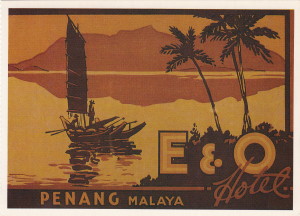 An E&O luggage label
An E&O luggage label
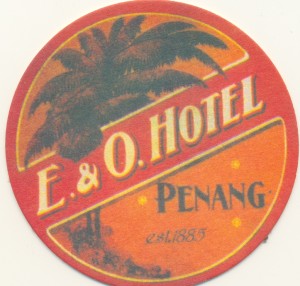
An E&O beer mat
Posted: March 5th, 2014 | No Comments »
Another book on the “hump” has appeared….
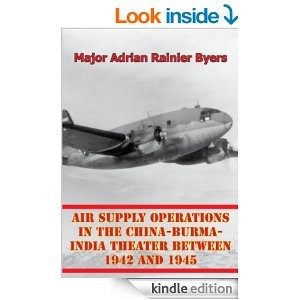
The USAAF responded to the requirement to keep China engaged against Japan by conducting two distinct air supply operations, a tactical air supply mission to Burma and a strategic air supply effort over the Himalayas to China. The tactical air supply effort to Burma supported offensive combat operations and the construction of the Ledo Road, while the Hump airlift directly contributed to the American strategic objective. Despite Stilwell’s stubborn commitment to the Ledo Road as the main effort to supply the Chinese and to the necessary use of tactical air supply to support this and other ground operations in Burma, the key contribution to the success of keeping China in the war against Japan was ultimately the strategic air supply missions over the Hump. This thesis reviews how the operational airlift efforts within the CBI supported both efforts and examines the challenges, processes, and development of air supply. The fundamental question associated with this effort concerns how the USAAF responded to seemingly competing air supply requirements in the CBI Theater in order to keep China in the war against Japan.
Posted: March 4th, 2014 | No Comments »
I’ve blogged before about Chung Ling Soo (here, here and here), actually William Ellsworth Robinson, an American magician who worked mostly in Britain before the First World War impersonating a Chinese magician in full mandarin regalia until a catching a bullet trick went wrong and he ended up dead at the Wood Green Empire. So thanks to the regular reader who sent me a copy of his own personalised headed paper….
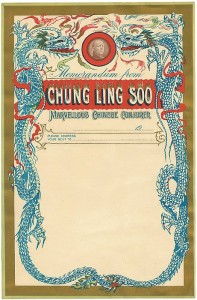
Posted: March 3rd, 2014 | No Comments »
Courtesy of the publishers Belfond, Midnight in Peking is now Minuit a Pekin and 21.50 of your finest euros! C’est fantastique!!

Entre document et polar, un « true crime » exceptionnel. Dans les derniers jours du Pékin colonisé, juste avant l’invasion japonaise, en plein chaos diplomatique, une enquête minutieuse et palpitante qui résout un mystère vieux de près de 80 ans. Un texte qui se lit comme un polar et qui a justement été récompensé par les prestigieux Dagger et Edgar Awards.
Entre polar compulsif et document édifiant, un true crime exceptionnel. Dans le Pékin des années 1930, en plein chaos diplomatique et dépravation morale, une enquête minutieuse qui résout un mystère vieux de près de quatre-vingts ans.
Par une froide nuit de janvier 1937, au pied de la tour de garde du vieux quartier de la Légation, le corps atrocement mutilé d’une jeune femme est retrouvé. Elle s’appelait Pamela Werner, elle avait vingt ans, elle était la fille adoptive de l’ancien consul de Grande-Bretagne.
Crime d’un rôdeur ou affaire d’État ? Dépêché par le Foreign Office, l’inspecteur Dennis lance l’enquête pour s’apercevoir rapidement que personne n’est pressé de voir la vérité triompher. Car Pékin est alors une véritable poudrière. Tandis que diplomates et seigneurs de la guerre complotent dans les fumeries d’opium, les expatriés se plongent dans une frénésie d’alcool, de drogue et de luxure pour oublier les rumeurs de l’invasion japonaise imminente et la fin annoncée de leurs privilèges. Et l’horrible assassinat de Pamela Werner pourrait bien faire l’effet d’une bombe diplomatique…
Soixante-quinze ans plus tard, après une enquête qui l’amènera à interroger les derniers témoins vivants et fouiller les notes jusqu’alors classées secret défense du père de la victime, Paul French dévoile le nom du monstre qui a tué Pamela et terrorisé Pékin.
Posted: March 3rd, 2014 | No Comments »
My mother was a member of the Companion Book Club in the 1950s (before I came along) and recently I came across a box of books from the Club she must have received around the mid-50s. It included a few interesting books that feature China, though she had no personal interest in the place and they were among the more usual fodder of long-forgotten romances and things like Lorna Doone. I feel, via the Companion Club, she was a voracious reader of what George Orwell termed “Good Bad Books” in an essay. I’m not sure how much she would have enjoyed Captain Anthony Farrar-Hockley’s The Edge of the Sword, but as an occasional Korea Hand I rather liked it. It’s the story of the Gloucestershire Regiments (the Glorious Gloucesters) in the Korean War, a well known story at the time. It follows their epic battle at the Imjin River and Farrar-Hockley’s capture by the Chinese and imprisonment by them for two and a half years.
Farrar-Hockley was kept in the Pyongyang Political Prison and subjected to psychological torture before escaping out through North Korea, a quite remarkable adventure. The book comes with two interesting maps (below), one of the Battle of the Imjin River and the other of the author’s escape route.

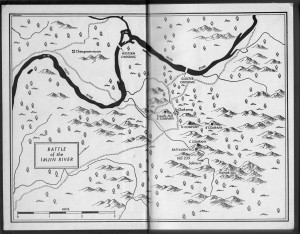
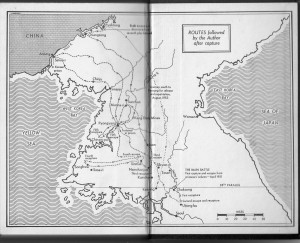
Posted: March 2nd, 2014 | 1 Comment »
Last week’s post on Carl Van Vechten reminded me that he shot a portrait of the author Thomas Handforth. Handforth (1897-1948), an American artist and teacher, is now best remembered for his children’s book Mei Li that was based on his experiences of China (and a real girl he met there) and has remained (at least until fairly recently) a perennial favourite kids book. It won the Caldecott Medal for illustration. The story deals with a young Chinese girl’s visit to a Chinese New Year festival in the countryside. It’s perhaps not the most politically correct book these days but the illustrations were charming (a selection below)….Handworth’s art was inspired by being given a book of Housaki’s drawings early on. In 1931 Handforth received a Guggenheim Fellowship for travel to China. He expected to spend two weeks in Peking, but stayed for six years, renting a space in an old courtyard house that had fallen into disrepair. In China he moved from etching to lithography because he felt that the spirit of China was better captured with a brush and a “greasy crayon.†The real Mei Li was the youngest of four Chinese girls adopted by Helen Burton, an extremely well known and well connected American woman in Peking who owned The Camel’s Bell Shop in the lobby of the Peking Hotel (A good bio of Burton remains to be written I think – unless there’s one I don’t know about?)
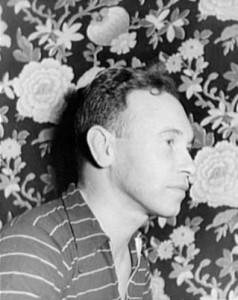 Handforth by Van Vechten
Handforth by Van Vechten
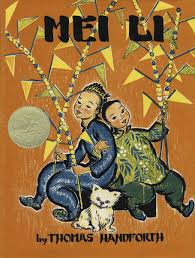



Posted: February 28th, 2014 | No Comments »
Crazily this exhibition has only run for a short time but if you’re in Hong Kong you can get over and see it at the Hong Kong Museum of History – it ends on the 3rd March. There’s a long review here and a link to the exhibit here. Sorry, to leave it a bit late!
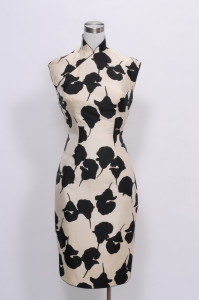
Hong Kong’s cheongsam culture dates back to the 1920s when teachers and students, ladies of prominent families as well as singers, film stars and Chinese opera performers began to wear the dress. In the 1940s, the large number of Shanghai tailors that moved to Hong Kong from the mainland ensured a plentiful supply of cheongsam tailors. With the changes in fashion trends among women in Hong Kong, the cheongsam then became a highly fashionable garment that was in huge demand in the 1950s and 1960s. As the tradition of the cheongsam has been passed down from generation to generation in Hong Kong society, the dress itself has seen a multitude of changes, but it has retained its popularity in the city, where it continues to be worn by many women to important occasions and to provide inspiration to up-and-coming fashion designers.
A Century of Fashion: Hong Kong Cheongsam Story exhibition is not only the opening programme of “Hong Kong Week 2013@Taipei”, it is also the first exhibition brought by our museum to Taiwan. To present this newly curated exhibition to the local audiences, we have come up with this abridged display introducing the transformation that the cheongsam has undergone in Hong Kong from the late Qing dynasty and early Republican period up to the present, while at the same time recounting the development of Hong Kong’s cheongsam industry, the characteristics of cheongsam craftsmanship and fascinating stories of Hong Kong women and their relationship with the cheongsam through different eras.
 In the 1930s and ’40s, Japanese political architects of the Manchukuo project in occupied northeast China realized the importance of using various cultural media to promote a modernization program in the region, as well as its expansion into other parts of Asia. Ironically, the writers and artists chosen to spread this imperialist message had left-wing political roots in Japan, where their work strongly favoured modernist, even avant-garde, styles of expression.
In the 1930s and ’40s, Japanese political architects of the Manchukuo project in occupied northeast China realized the importance of using various cultural media to promote a modernization program in the region, as well as its expansion into other parts of Asia. Ironically, the writers and artists chosen to spread this imperialist message had left-wing political roots in Japan, where their work strongly favoured modernist, even avant-garde, styles of expression.












